Gelatin Hydrolysis Test- Principle, Uses, Media, Procedure and Result
Gelatin Hydrolysis Test- Principle, Uses, Media, Procedure and Result
Gelatin is a protein derived from the animal protein collagen, a component of connective tissue and tendons in human and other animals. It has been used as a solidifying agent in food for a long time. Robert Koch used nutrient gelatin as an early type of solid growth medium.
Gelatin dissolves in water at 50 degree Celsius and exists as liquid above 25°C and solidifies or gels when cooled below 25°C.
Principle of Gelatin Hydrolysis Test
This test is used to determine the ability of an organism to produce extracellular proteolytic enzymes, gelatinases that hydrolyze gelatin. The reaction occurs in two sequential steps: in first reaction gelatinases hydrolyze gelatin into polypeptides and then polypeptides are further converted into amino acids as shown in figure.
 The amino acid is taken up by the cell and used for metabolic purposes.
The amino acid is taken up by the cell and used for metabolic purposes.
The presence of gelatinases is detected using a nutrient gelatin medium. This medium is a simple medium composed of gelatin, peptone and beef extract. When nutrient gelatin tube is stab-inoculated with a gelatinase positive organisms, the secreted gelatinases will liquefy the gelatin, resulting in the liquefaction of the medium. While the gelatinase negative organisms do not secrete enzymes and do not liquefy the medium.
Uses of Gelatin Hydrolysis Test
- This test is used to determine the ability of an organism that produce gelatinases.
- This test is helpful in identifying and differentiating species of Serratia, Proteus, Bacillus, Clostridium, Pseudomonas and Flavobacterium.
- This test differentiates pathogenic Staphylococcus aureus which is gelatinase-positive from non-pathogenic epidermidis which is gelatinase negative.
- This test can be used to differentiate Serratia and Proteus species which are gelatin positive from other members of Enterobacteriaceae family.
- Bacillus anthracis, B. cereus and several other members of the genus are gelatinase-positive, as are Clostridium tetani and perfringens.
Media and Reagents used for Gelatin Liquefaction
Ingredients per liter:
Gelatin 120g/l
peptone 5g/l
Beef extract 3g/l
Final pH: 6.8±0.2 at 25°C.
Preparation
- Dissolve all ingredients in 1000ml of distilled water or deionized water.
- Dispense 2-3 ml of medium into test tubes (13 x 100 mm).
- Autoclave the test tubes at 121°C and 15 psi for 15 minutes.
- Allow the tube to cool in an upright position before use.
- Store the prepared medium at 2-8°C.
Procedure of Gelatin Hydrolysis Test
There are several methods for determining gelatin hydrolysis test such as gelatin stab method, plate method, X-ray method, Kohn method, all of which use gelatin as the substrate. The standard and most commonly used method is the nutrient gelatin stab method.
- Pick up several well-isolated colonies of 24 hour old with a sterile needle.
- Inoculate the nutrient gelatin medium with a test inoculum by stabbing 4 to 5 times half inch into the medium.
- Incubate the test and an un-inoculated tube for 48 hour at 37°C. (Note: incubate the medium at 25°C if the organism grows better at 25°C than at 35°C)
- Gently remove the inoculated and uninoculated tubes from the incubator and place in ice bath or refrigerate for at least 30 min. or until the control tube solidifies. (Gelatin is a liquid at 28°C or above).
(NOTE: i. Do not shake or invert the tubes prior to refrigeration. ii. Gently invert to detect liquefaction by the test organism after 30 min of refrigeration.)
5. Re-incubate a negative test for up to 2 weeks if indicated by the nature of the organism and examine at regular intervals.
Expected results
Positive: Partial or complete liquefaction of the inoculated tube at 4°C. The control tube remain solidified even after exposure to cold temperature.
Examples: Aeromonas hydrophila, Bacillus subtilis
Negative: At the end of the refrigeration, the control tube and the test tube both remain completely solidified.
Examples: Micrococcus roseus, Escherichia coli
Quality control
Positive: Pseudomonas aeruginosa ATCC 10145
Negative: Escherichia coli ATCC 25922
Limitation
- Gelatinase usually acts at the surface of the medium. Shaking the tube while it is warm may result in false-negative interpretation.
- Gelatin may vary in gelling ability. Therefore, incubate an uninoculated control with the test. The control must be refrigerated along with the test, prior to reading.


The test method is cool
How does shaking of the tubes result in false-negative interpretation?
Thanks
Very helpful. Please also produce the same for other extracellular enzyme assays, such as Lipase activity, DNase activity, especially Hyalurodinase activity (that i am currently struggling with) and others. Thanks in advance.
very good
It is a very good method. Can you please provide reference